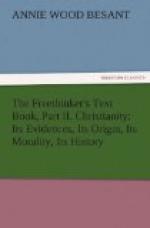that King is Solomon; in Luke, Nathan; and so on,
the line descends, in Matthew, through the race of
known Kings; in Luke, through an unknown collateral
branch, coinciding only with respect to Salathiel and
Zorobabel, whilst they still differ in the names of
the father of Salathiel and the son of Zorobabel....
A consideration of the insurmountable difficulties,
which unavoidably embarrass every attempt to bring
these two genealogies into harmony with one another,
will lead us to despair of reconciling them, and will
incline us to acknowledge, with the more free-thinking
class of critics, that they are mutually contradictory.
Consequently, they cannot both be true.... In
fact, then, neither table has any advantage over the
other. If the one is unhistorical, so also is
the other, since it is very improbable that the genealogy
of an obscure family like that of Joseph, extending
through so long a series of generations, should have
been preserved during all the confusion of the exile,
and the disturbed period that followed.... According
to the prophecies, the Messiah could only spring from
David. When, therefore, a Galilean, whose lineage
was utterly unknown, and of whom consequently no one
could prove that he was not descended from David,
had acquired the reputation of being the Messiah;
what more natural than that tradition should, under
different forms, have early ascribed to him a Davidical
descent, and that genealogical tables, corresponding
with this tradition, should have been formed? which,
however, as they were constructed upon no certain data,
would necessarily exhibit such differences and contradictions
as we find actually existing between the genealogies
in Matthew and in Luke” ("Life of Jesus,”
by Strauss, vol. i., pp. 130, 131, and 137-139).
The accounts of the several angelic warnings to Mary
and to Joseph appear to be mutually exclusive.
Most theologians, says Strauss, “maintaining,
and justly, that the silence of one Evangelist concerning
an event which is narrated by the other, is not a negation
of the event, they blend the two accounts together
in the following manner: 1, the angel makes known
to Mary her approaching pregnancy (Luke); 2, she then
journeys to Elizabeth (the same Gospel); 3, after her
return, her situation being discovered, Joseph takes
offence (Matthew); whereupon, 4, he likewise is visited
by an angelic apparition (the same Gospel). But
this arrangement of the incidents is, as Schliermacher
has already remarked, full of difficulty; and it seems
that what is related by one Evangelist is not only
pre-supposed, but excluded, by the other. For,
in the first place, the conduct of the angel who appears
to Joseph is not easily explained, if the same, or
another, angel had previously appeared to Mary.
The angel (in Matthew) speaks altogether as if his
communication were the first in this affair. He
neither refers to the message previously received
by Mary, nor reproaches Joseph because he had not
believed it; but, more than all, the informing Joseph




